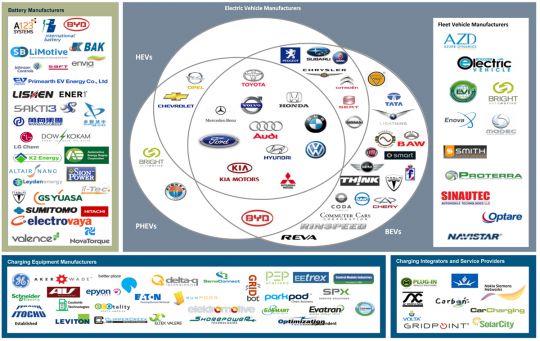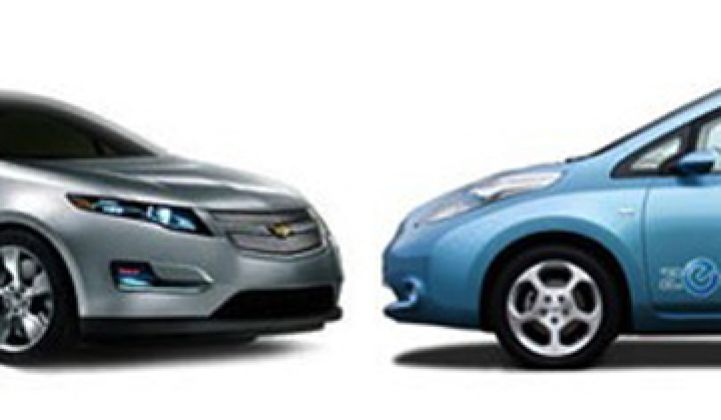This is the third piece in a four-part series, offering insights and perspectives from GTM Research's latest Smart Grid report, Electric Vehicles 2011: Technology, Economics, and Market. To read part one, click here. Part two is here.
Nissan LEAF versus Chevy Volt: Therein lies the battle for dominion in the early adoption market for electric vehicles (EVs), stoked by sensationalist journalism and sassy marketing departments. When judged by their commercials [1], LEAF against Volt appears to be a duel between two technology platforms: all-electric vehicles (also called battery-electric vehicles, or BEVs) versus plug-in hybrid electric vehicles (PHEVs).
The tensions between BEVs and PHEVs become clear in almost every aspect of manufacturing, purchasing, and operating a vehicle. Here, we look into some of these tensions and explore the question of whether there can be peaceful coexistence between the two technology platforms or whether one will ultimately prevail.
Driving Range
The most striking difference between a BEV and a PHEV is that the former has a driving range limited by the energy storage capacity of its battery, while the latter is equipped with a liquid fuel tank and an internal combustion engine, and therefore has virtually unlimited driving range. As such, manufacturers of BEVs and PHEVs make different assumptions about the driving patterns and preferences of their customers.
According to the latest National Household Travel Survey, 89% of all car trips are shorter than 20 miles, and the average driver travels 29.7 miles per day. The Nissan LEAF, which comes with a 24-kWh battery and a stated 100-mile driving range, covers these distances easily. Yet the challenge is not in accommodating average trips -- it’s about the outliers, those trips going farther than 100 miles. Most people want to drive their cars anywhere, anytime and not cut their trips short or spend hours waiting for a charge. So in the absence of a dense network of fast-charging stations, PHEVs have a significant advantage over BEVs, as captured by Chevy’s tagline: “Charge Anywhere, Drive Everywhere.”
Costs
In a world in which battery costs account for the bulk of the incremental costs of an EV over a comparable ICE, PHEVs have an advantage over BEVs, as they can be equipped with a smaller battery. The Toyota Prius Plug-In comes with a 5.2-kWh battery, significantly smaller than the LEAF’s 24-kWh battery. (The Chevy Volt has a 16 kWh battery but only uses 50% of its capacity.) Granted, PHEVs incur other costs that BEVs do not (such as the cost for the internal combustion engine), but those are not sufficiently high to offset the battery cost differential. The net effect is that PHEVs are offered at lower upfront costs than comparable BEVs.
What about operating costs? It is clear that a mile driven electrically is cheaper than a mile driven on gasoline. We speculate that the typical PHEV will be equipped with a battery large enough to enable all-electric drive for 90% of trips, so that the total operating costs will be similar in the end.
Manufacturing
The figure below depicts the current vehicle manufacturing landscape. It is clear that most established car companies are pursuing a multi-platform technology strategy, with plans to offer a range of hybrid-electric vehicles (HEVs), BEVs, and PHEVs. Notable exceptions include the two General Motors brands Chevrolet and Opel, which have hitherto focused on PHEVs.
It is interesting to note that most independent companies (with the exception of Fisker Automotive) seem to be focusing on BEVs. We speculate that there may be two reasons for this, one rooted in the supply side and the other in demand. First, it takes considerably more expertise and capital to develop a PHEV than a BEV, as the latter does not include an ICE and is thus simpler to engineer and build. As a result, independent car manufacturers may find it easier to develop and manufacture an all-electric car. Second, independent car manufacturers are less path-dependent than established companies and may find it easier to adapt their product strategy to market demand. But whether or not consumers indeed prefer BEVs over PHEVs remains to be seen.
Figure: High-Level Electric Vehicle Market Taxonomy

Source: GTM Research
Charging and Reliance on Public Charging Infrastructure
Finally, there is considerable difference in the reliance on public charging infrastructure. PHEVs can be refueled at any gas station, of which there are more than 164,000 in the United States. BEVs, however, rely on public charging infrastructure. In the early years, when public charging spots are few and far between, PHEVs offer their drivers more flexibility and freedom than BEVs. It would not be the first time in cleantech history that a small early lead for one technology platform translates into a substantial commercial lead (due to economies of scale and learning effects), driving rival technology platforms to the outer edges of the market (think photovoltaic vs. thin film in solar).
Conclusions
In our view, there is little that speaks for BEVs these days in light of higher costs, limited driving range, and the reliance on nonexistent public charging infrastructure. Peaceful coexistence or life-or-death battle? You be the judge.
[1] Nissan LEAF: http://www.youtube.com/watch?v=Nn__9hLJKAk, Chevy Volt: http://www.youtube.com/watch?v=6UAQaTuftM8



